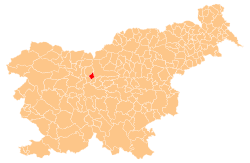Komenda
Komenda (pronounced [kɔˈmɛːnda]; German: Commenda[2]) is a village in the Upper Carniola region of Slovenia. It is the seat of the Municipality of Komenda.[3] It includes the formerly independent settlement of Kaplja Vas (Slovene: Kapla vas, German: Kaplawas[2]).[4]
Komenda | |
|---|---|
 | |
 Komenda Location in Slovenia | |
| Coordinates: 46°12′26.20″N 14°32′20.55″E | |
| Country | |
| Traditional region | Upper Carniola |
| Statistical region | Central Slovenia |
| Municipality | Komenda |
| Area | |
| • Total | 2.40 km2 (0.93 sq mi) |
| Elevation | 346.8 m (1,137.8 ft) |
| Population (2012) | |
| • Total | 896 |
| [1] | |
Name
Komenda was first mentioned in written sources in 1147–54 as de sancto Petro (and as hospitale Sancti Petri in 1296, in der pharren von Sand Peter in 1322, and comendator ad S. Petrum in 1446). The name of the village is identical to the Slovene common noun komenda 'commandry', referring to a property and residence owned by the Knights Hospitaller from 1223 to 1872. The noun komenda is borrowed (probably via German Kommende) from Medieval Latin commenda 'entrusted property'.[5] In the past the German name was Commenda.[2]
Mass grave

Komenda is the site of a mass grave from the period immediately after the Second World War. The Svešek Alder Mass Grave (Slovene: Grobišče Sveščeva jelša) is located at the edge of the Svešek Alder Woods (Sveščeva Jelša) along a forest road northwest of Žeje pri Komendi. It contains the remains of 10 to 15 prisoners from Kamnik murdered in May and June 1945. Their nationalities and whether they were soldiers or civilians is unknown.[6]
Church
Above the settlement is a complex with a castle, the parish church dedicated to Saint Peter, a parsonage, stables and a cemetery. A church in Komenda was first referred to in documents dating to 1147, however in 1726 the old church was pulled down to make way for the new building. The current one was built in the Baroque style until 1729 upon the plans by the architect Gregor Maček, Jr. The interior and the surroundings were redesigned in the first half of the 20th century upon the plans by the architect Jože Plečnik.[7]
Notable people
Notable people that were born or lived in Komenda include:
- Pietro Giacomo de Testaferrata (Slovene: Peter Jakob de Testaferrata; 1673–1763), Maltese knight
- Peter Pavel Glavar (1721–1784), priest, beekeeper, writer, and businessman[8]
- Ivan Selan (1902–1981), cartographer
- France Pibernik (born 1928), poet and writer
- Ivan Sivec (born 1949), writer and journalist
- Agata Zupin (born 1998), hurdles runner[9]
- Tadej Pogačar (born 1998), cyclist
Twin municipalities

Gallery
 The horse track and the church
The horse track and the church The Baroque portal of the house and library of Peter Pavel Glavar, designed by Franc Jelovšek
The Baroque portal of the house and library of Peter Pavel Glavar, designed by Franc Jelovšek
 Šmid Manor, built in the 15th century
Šmid Manor, built in the 15th century
References
- Statistical Office of the Republic of Slovenia Archived November 18, 2008, at the Wayback Machine
- Leksikon občin kraljestev in dežel zastopanih v državnem zboru, vol. 6: Kranjsko. 1906. Vienna: C. Kr. Dvorna in Državna Tiskarna, pp. 26–27.
- Komenda municipal site (in Slovene)
- Savnik, Roman, ed. 1971. Krajevni leksikon Slovenije, vol. 2. Ljubljana: Državna založba Slovenije. pp. 185–186.
- Snoj, Marko. 2009. Etimološki slovar slovenskih zemljepisnih imen. Ljubljana: Modrijan and Založba ZRC, p. 197.
- Ferenc, Mitja (December 2009). "Grobišče Sveščeva jelša". Geopedia (in Slovenian). Ljubljana: Služba za vojna grobišča, Ministrstvo za delo, družino in socialne zadeve. Retrieved April 15, 2020.
- Slovenian Tourist Board site
- Bokal, Ljudmila, ed. 2008. Čebelarski terminološki slovar. Ljubljana: Založba ZRC, ZRC SAZU and Lukovica: Čebelarska zveza Slovenije, p. 254.
- Kastelic, Peter (June 10, 2017). "Mlada slovenska šprinterka presenetila z normo za svetovno prvenstvo". Siol.net. Retrieved January 13, 2018.
- Po poteh kulturne dediščine v občini Komenda [Following the Paths of the Cultural Heritage in the Municipality of Komenda] (in Slovenian). Municipality of Komenda. 2006. COBISS 228815360.
External links
| Wikimedia Commons has media related to Komenda. |
- Komenda municipal site (in Slovene)
- Komenda at Geopedia.si
